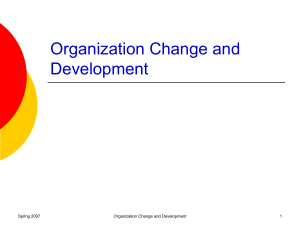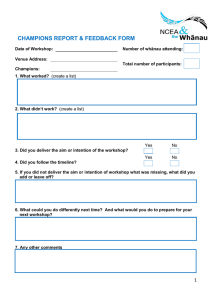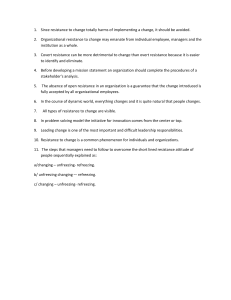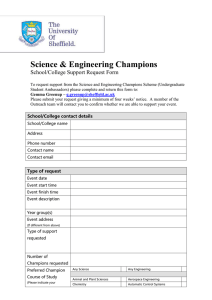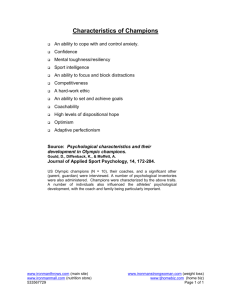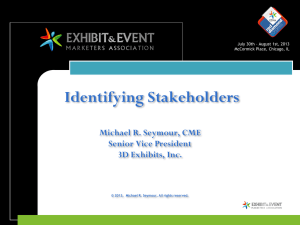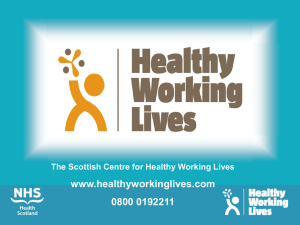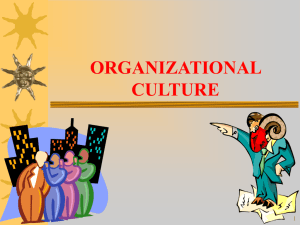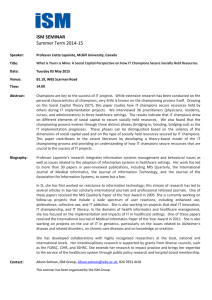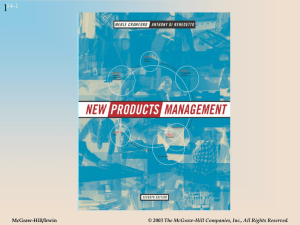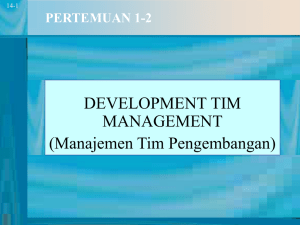Chapter 16
advertisement
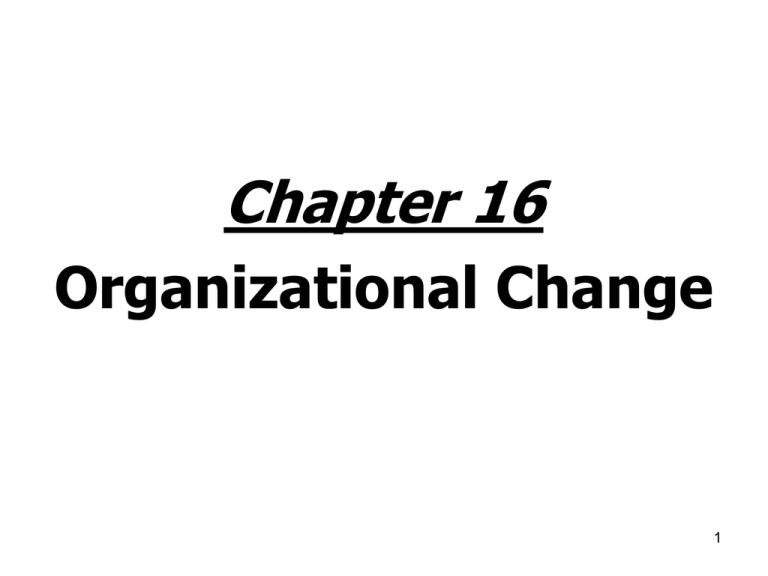
Chapter 16 Organizational Change 1 What Are the Forces Acting as Stimulants to Organizational Change? • Evolving nature of workforce • Technological advances • Economic shocks • Heightened competition • Social and consumer trends • World politics and globalization 2 Individual Barriers to Change (textbook’s) • Habits • Need for security • Economic fears • Fear of unknown • Selective information processing 3 Individual Barriers to Change (M. Stevens’) • Cognitive barriers (knowing) - Limited mental models - Self-awareness biases • Skill-set barriers (doing) • Affective barriers (feeling) • Character/values barriers (being) 4 Organizational Barriers to Change • Structural inertia • Limited focus of change (no “systems” view) • Group inertia and constraints • Threats to specialized expertise • Threats to established power relationships • Threats to established resource allocations 5 Dealing With Resistance • Change agents/champions • Education and communication • Participation and involvement • Building emotional commitment • Implementation with fairness • Cooptation and manipulation • Better selection on front end • Explicit and implicit coercion 6 Lewin’s Force Field Analysis Unfreezing Changing Refreezing 7 Kotter’s Eight Step Process 1. Create urgency 5. Empower others 2. Form coalition 3. Create new vision 4. Communicate the vision 6. Reward “wins” 7. Consolidate improvements Movement Refreezing Unfreezing 8. Reinforce the change 8 Organizational Development A collection of planned-change interventions that seek to improve organizational effectiveness and employee well-being. Based on humanistic & democratic values: - Respect for people - Trust and support - Power equalization - Confrontation - Participation 9 Typical OD Interventions • Sensitivity Training - Changing behavior through unstructured group interaction • Survey Feedback - Gathering data and acting on it • Process Consultation - Using outside consultants • Appreciative Inquiry - Discovering what the organization does right 10 Creating a Culture for Change Innovation: New ideas applied to initiating or improving a product, process, or service. Sources: - Structural: Highly communicative, organic structures, slack resources, and managers with long tenure. - Cultural: Encourage experimentation, reward both successes and failures, and celebrate mistakes. - Human Resources: Actively promote training and development, offer high levels of job security, and use change/idea champions. 11 Idea Champions Champions: People who actively and enthusiastically promote an idea, build support, overcome resistance, and ensure that innovation is implemented. These people: – Have high self-confidence, persistence, energy; – Have high tolerance for risk; – Use inspiration and vision to gain commitment; – Have decision-making discretion. 12 Contemporary Issues A. Technology in the Workplace B. Work Stress C. Creating Learning Organizations 13 A. Technology in the Workplace Continuous Improvement Process: - Goal is constant reduction in variability - Uniformity results in lower costs, higher quality, and increased stress Process Reengineering: - How you would do things if you could start over from scratch - Very stressful for everyone 14 B. Work Stress Stress: A dynamic condition in which an individual is confronted with an opportunity, constraint, or demand related to what is desired and for which the outcome is perceived to be both uncertain and important. Two types of stress: • Challenge Stress: Typically improves performance • Hindrance Stress: Comes from obstacles to achieving goals (mostly negative). 15 Strategies for Managing Stress Organizational Personal • Employee Selection • Counseling • Org. Communication • Time Management • Goal-setting Programs • Physical Activity • Job Redesign Note: Managers have no direct control over personal (or life) stressors and as a result should be aware that there are ethical considerations about intruding into employees’ personal lives. 16 C. Creating a Learning Organization An idealized organization that has developed the continuous capacity to adapt and change. Types of Learning: – Single-Loop: Error correction process that relies on past routines and present policies. – Double-Loop: Errors are corrected in ways that involve modification of the organization’s objectives, policies and standard routines (typically used by learning organizations). 17 Five Basic Characteristics of a Learning Organization People in a learning organization: 1. 2. 3. 4. 5. Are willing to put aside old ways of thinking; Learn to be open with each other; Understand how the organization really works; Form plans or visions that everyone agrees on; Work together to achieve that plan or vision. 18 Learning Organizations... • Solve three fundamental problems of traditional organizations: - Fragmentation (due to functional silos) - Competition (overemphasis undermines collaboration) - Reactiveness (“firefighting”) • To Manage the Learning Process: - Proactively establish a strategy - Redesign the organization’s structure - Reshape the organization’s culture 19
